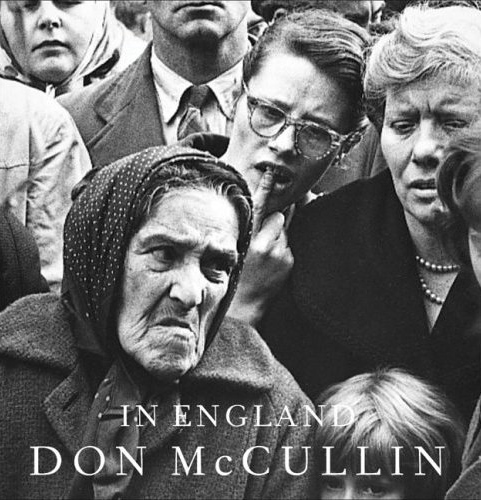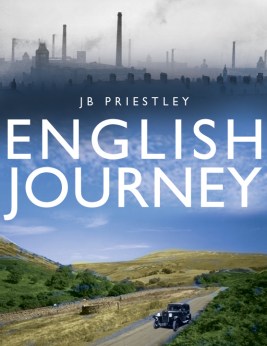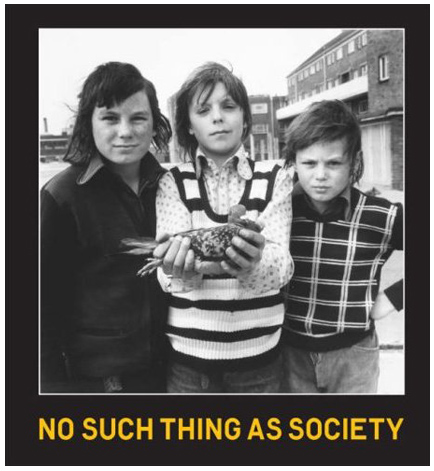“Once upon a time I lived in a double-decker bus, reg. JRR 404, better known as the Free Photographic Omnibus. She was my home, my travelling darkroom and gallery” writes Daniel Meadows on his Photobus website.
“People ask: “Where are you from?” and I have to tell them that really I don’t know. What I do know is that I’m English. And this story is about the England I come from.
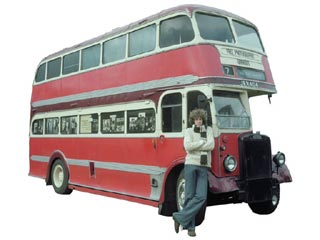
We were an unlikely couple; she with her crash gear box and temperamental ways, me with my bushy hair and homemade flares. But we got along okay and, during 1973 and ’74, we travelled about making a national portrait of the English. We covered 10,000 miles shooting pictures and giving them away. The bus’s glory days, taking holiday-makers on seaside runs to Skegness and Mablethorpe, were in the 1950s but, by the time I got to know her, she was 25 years old and (it has to be said) past her best. By comparison I — fresh out of art school and all of four years her junior — was just a whipper-snapper.”
Photographer and university lecturer Daniel Meadows is recognised as one of the prime movers in the new documentary photography movement of 1970s Britain and is best known of his tour around England in the Free Photographic Omnibus (1973-74).
In 1973 – just out of Art School – Meadows bought a double-decker bus and spent 14 months travelling through English towns. When he pulled up, he took free portraits of people who came to his bus which was fitted out as a mini-studio. In the course of a 14-month journey, he offered free portrait sessions in 22 different towns, developing the black and white prints in a darkroom he had contrived inside the bus, in which he also lived. He photographed a total of 958 people, alone or in groups, the majority of whom remained anonymous and collected their free portraits the following day.
The result was a series of photographs he called ‘National Portraits’, a selection of which you can see here-
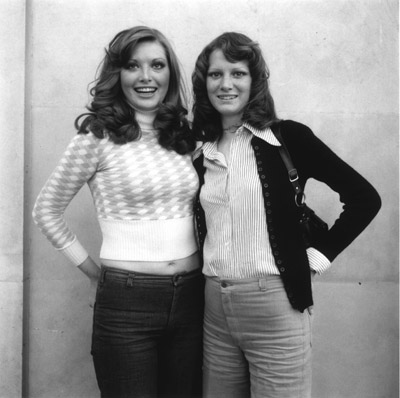
Lyn & Stella Brasher, Sisters, Southampton © Daniel Meadows, 1974

© Daniel Meadows, 1974

© Daniel Meadows, 1974

© Daniel Meadows, 1974

© Daniel Meadows, 1974

© Daniel Meadows, 1974

© Daniel Meadows, 1974

© Daniel Meadows, 1974

© Daniel Meadows, 1974
You can view a slideshow with more images from the series on Meadows’ website here.
In 1999Â Meadows decided to ‘go back’ and re-photograph some of his original ‘subjects’. He ‘found’ them by putting original photographs in local papers. The two series of portraits (from 1974 and 1999) were then published alongside each other in a book called The Bus: The Free Photographic Omnibus 1973-2001 (The Harvill Press, London, 2001).
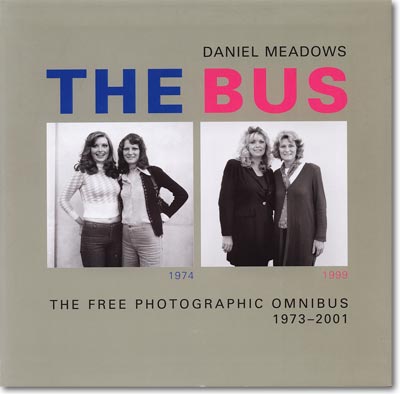
With the help of the local press in Barrow-in-Furness, Hartlepool and Southampton, he went in search of them. Many could not be found, others had died, but a number of people turned up to be re-photographed. The juxtaposition of their past and present selves makes for a unique pictorial history of the changing face of England (particularly the vagaries of fashion, and the ravages of time). Meadows interviews the sitters, ordinary people from varied walks of life, who talk candidly about their lives, their friends, their loves, their families and what they feel.
You can take multi-media tour on Meadows’ bus here.
Posted in ENGLISHNESS, OTHER STUDIES | 2 Comments »
I’ve just come across details of an intriguing new book published by Dewis Lewis called In A Very English Town. John Comino-James has photographed the streets, shops and shopkeepers in the centre of Thame, an historic market town some 45 miles from London. Comino-James studied his local town after being asked by a Cuban friend to show her life in his area. His series of panoramic photographs were taken between July 2007 – June 2008 and are laid out in the book in a sequence representing a meandering walk through the town.
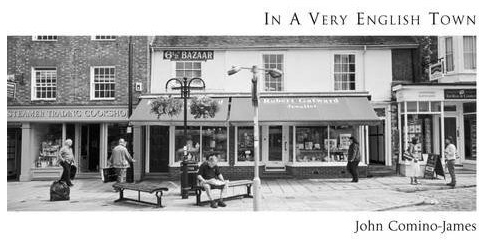
£19.99
Hardback, 168 pages
110 duotone photographs
160mm x 295mm
Here are the publishers notes on the book-
“High Street, Buttermarket, Cornmarket, Pump Lane, North Street, Park Street, have such a deceptive familiarity to the English ear that they might be found in any English town. They are names that suggest a sense of continuity and tradition – something very English. Yet the reality is often not quite what it appears.
Portraits, texts and candid photographs which document everything from the last cattle market operating in the area, travelling showmen at one of the two annual fairs, and the weekly street market. The accompanying interviews reveal pride in the continuation of family businesses, as well as small enterprises both challenged by and benefiting from the increasing impact of the internet.
While the presence of supermarkets and services such as banks, travel agents and estate agents is acknowledged, in choosing subjects for portraits Comino-James was drawn to those shopkeepers whose aim might be summed up in the words of one of them: ‘To keep the character of Thame as a Market Town and not a Supermarket town’.”
You can see a slideshow of photographs on the Guardian website here.
Posted in OTHER STUDIES | Comments Off on IN A VERY ENGLISH TOWN
One of the first photography books I was given as a teenager was Don McCullin’s autobiography Unreasonable Behaviour (Jonathan Cape, 1990). It was powerful reading and certainly made a huge impression on me at a time when I was just beginning to explore the medium for myself. After a career spanning 50 years McCullin documented every major conflict in his adult lifetime up until the Falklands war. During this period, he also continued to document the dramas, injustices and eccentricities of his own country – England. Work which was published a couple of years ago, Don McCullin In England (Jonathan Cape, 2007).
“So much of my war reporting had involved watching national identities take shape that I began to ask myself who I was. What were the English and what did they represent? What for that matter did I represent? ” (McCullin, 1990).
Finally, a major exhibition of the work has just opened at the National Media Museum and runs until the 27th September 2009.
It’s described as “a dark, often uncomfortable vision of a divided nation where the gulf between rich and poor remains as defined as ever. However, McCullin balances his anger at social injustice with great humanity, compassion, lyricism and occasional humour.”
The NMM have set up a pretty extensive website around the exhibition with video interviews and links to McCullin’s work. It’s certainly worth having a look at. In the meantime, here are a few of the pictures from the exhibition, alongside some quotes from McCullin (taken from the NMM website):

The Guv’nors, Finsbury Park, London © Don McCullin, 1958
“I was just an amateur, feeling my way with no real knowledge of what I was doing. At the same time I had found a direction… In the next four years I started learning what photography was all about and gaining a broader picture of the world than I’d ever had in Finsbury Park, where it all began.” (Don McCullin,1994)

Mother and son, Bradford © Don McCullin, 1978
“I stopped wandering when I reached Bradford, where I found a microcosm of the dark satanic legacy that we had inherited from Britain’s industrial heyday … I was met everywhere by warm and courteous people … In Bradford I experienced a new freedom, wandering through the quiet dilapidated streets where, for the first time in years, I encountered a great deal of hospitality and the welcome absence of violence. I discovered here a city, a living city, and in so doing I rediscovered myself – not always a comfortable process.” (Don McCullin,1994)

East End, London © Don McCullin, 1973
“For six weeks in the winter of 1969 I appeared at dawn on the streets of Whitechapel in London’s East End … Communication was difficult at the best of times, for I was dealing with alcoholics and schizophrenics who were sometimes violent and dangerous … Stealing pictures of these people with a long lens was not my style. I wanted to be close to them, to feel their plight and to convey the emotion of contact with them. I wanted their trust and to become their voice.” (Don McCullin,1994)

Mayfair, London © Don McCullin, 1965
“We are not as class conscious as we used to be but there is still that barrier there… It’s a tricky place this country, even though it’s changed during the years from Thatcher to Blair. But if you’re a photographer, you can exploit some of those unpleasant and tricky sides to it… It’s tricky this country but I like that because it’s a challenge.” (Don McCullin, 2009)

Bradford © Don McCullin, 1973
“I can’t describe how I feel when I’ve had a good day photographing people, having met and talked to them and had their co-operation. It’s as if somebody’s given me an enormous present; I go home as if I’ve got a full belly.” (Don McCullin, 1979)

Towards an Iron Age hill fort, Somerset © Don McCullin, 1991
“I’m probably the only person in England who’s anxious for the winter. As soon as the leaves of autumn start falling from the trees, I become reactivated, the opposite of a hibernating animal. I know that I’ve got four long months of darkness, wind and cold to exercise my masochism. The English landscape’s known for its Constable summers but I’m obsessed with photographing it in the dead of winter, at its hardest … I love the winter – not the climate, but the struggle, its abrasiveness, the nakedness of the landscape.” (Don McCullin, 1979)
Don McCullin reviews his career with John Tusa on BBC Radio 3 here
(August 2002).
Observer interview covering his career, with great detail on his early years here
(August 2005).
Posted in OTHER STUDIES | Comments Off on DON McCULLIN – IN ENGLAND
I’ve just been informed that a 75th anniversary edition of JB Priestley’s classic book, ‘English Journey’ is to be published by
Great Northern Books in July 2009.
The book will feature archive and contemporary images of the places visited by Priestley on his journey, an original unabridged version of Priestley’s text, which was first published in 1934, alongside an introduction by Tom Priestley (JBP’s son) and an essay on the social, political and literary legacy of the book by Lee Hanson. It will also contain essays on Priestley and specific locations featured in the book by Margaret Drabble, Nina Bawden, Roy Hattersley, Alan Plater, William Woodruff, Dr John Baxendale and Beryl Bainbridge.
English Journey will be featured at the London Festival of Literature, The Purcell Room, Southbank Centre on Friday 10 July, at which Tom Priestley and Margaret Drabble will speak about, and answer questions on, Priestley’s legacy.
Posted in OTHER STUDIES | Comments Off on PRIESTLEY’S ENGLISH JOURNEY, 2009 EDITION
“What one man saw, heard, thought and felt on a journey through England†J B Priestly, quoted in English Journey
I was pleased to hear from another British photographer, John Angerson, who is heading out on the road documenting England. Angerson is following in the footsteps of J.B. Priestley who wrote English Journey, a celebrated account of his travels through rural and industrial England in the 1930s. 2009 marks the 75th anniversary of its publication.
Angerson says his project will “highlight– as Priestley did – industry, migration, shifting communities, and citizenship, questions that were as relevant in the 1930s as they are now. Priestley’s English Journey is an example of an individual’s perception of place, and how a place is determined by the particular viewpoint from which it is observed. This is relevant to what we know about the nature of photography. Photographs are subjective- documentary photography can only ever be about the photographer’s perceptions of places, and people they encounter.”
Here are some of his early photographs-

Rob Brown, Deputy Manager of Campanile, French hotel chain, Leicester © John Angerson

Etap hotel, West Quay Road, Southampton. Price per night £46.00 © John Angerson

Student James Cottle, Coventry © John Angerson

Lish Fernandes, call centre worker and finalist in the Miss Wiltshire Beauty contest, Swindon © John Angerson

Black Castle Public House, Brislington, Bristol © John Angerson

Cruise liner in Southampton, Docks for repairs © John Angerson

New housing estate, Baildon, Bradford © John Angerson

Asim Bukhari, worker at NG Bailey, a building service solutions company © John Angerson

The Sweet Centre restaurant, Lumb Lane, Bradford © John Angerson

Stafford Roadchef Services, Junction 15, M6 motorway, Stoke-on-Trent © John Angerson

Anna Baranovska orginally from Latvia who was shortlisted for Miss England, Birmingham © John Angerson

Carpeo Ltd is a 2500 square foot Call centre with 130 employees, Swindon © John Angerson
You can see more on his website. I’ve also sent a few questions to John about the project which I’ll hopefully be able to post up soon.










Posted in OTHER STUDIES, RESEARCH | 2 Comments »
The British Prime Minister, Margaret Thatcher, famously announced that ‘There is no such thing as society’ (October 31, 1987), a quote which has been borrowed for the title of a relatively recent publication about British photography. No Such Thing As Society: Photography in Britiain, 1967-1987 by David Alan Mellor (Hayward Publishing, London, 2008), draws from the collections of the Arts Council and the British Council to give an appraisal of these two turbulent decades.
Book cover featuring photograph by Daniel Meadows
The early 1970s saw the emergence of new and independent approaches to documentary photography which focused on social realism. The leading exponent, Tony Ray-Jones, captured the comedies of social class and the absurdities of human behaviour within the constraints of British culture. The human costs of de-industrialisation and globalisation were the great central themes of the documentary photographers active in the North of England in the late 70s and 80s. The social disasters captured in Chris Killip’s work extended into the darkly coloured, claustrophobic interiors of DHSS offices photographed by Paul Graham, and Martin Parr’s lividly coloured documents of holiday makers in New Brighton, Liverpool. By the end of the 80s, the status of photography within the artistic context had been established. Motifs of intense political dissatisfaction spread across the urban vistas of Ian Dobbie, while more conventional forms of photo-journalism of urban conflict in the North of Ireland and the streets of South London were employed by Philip Jones-Griffith and Paul Graham.

Beauty Contest, Southport © Tony Ray-Jones, 1967. British Council Collection, London.
No Such Thing As Society has been curated by David Alan Mellor, Professor of Art History at the University of Sussex. He has written and curated extensively on aspects of post-war British art and photography, including Antonioni’s Blow-Up, London 1966 (2006), Liliane Lijn, Works, 1958-1980 (2005), Interpreting Lucian Freud (2003), and The Art of Robyn Denny (2002).
Emma’s Wedding © David Butterworth, 2007. Arts Council Collection, Southbank Centre.
Artists included in the book are-
Keith Arnatt, John Benton Harris, Ian Berry, Derek Boshier, Victor Burgin, Vanley Burke, David Butterworth, David Chadwick, Tarik Chawdry, John Davies, Ian Dobbie, Peter Fraser, Gilbert & George, Paul Graham, Brian Griffin, Christine Hobbeheydar, Cragie Horsfield, Alexis Hunter, Phillip Jones-Griffiths, Chris Killip, Bob Long, Markéta Luskacová, Ron McCormick, Peter Marlow, Daniel Meadows, Peter Mitchell, Raymond Moore, Tish Murtha, Martin Parr, Gilles Peress, Tony Ray-Jones, Jurgen Schadeberg, Graham Smith, Chris Steele-Perkins, Homer Sykes, Paul Trevor.
You can read a review of the project by in Frieze here.
And an interesting interview with Mellor in The Guardian here.
Posted in OTHER STUDIES | Comments Off on NO SUCH THING AS SOCIETY
I was interested to listen to photographer Tom Hunter’s somewhat candid presentation last weekend at the Rhubarb Rhubarb Cultivate seminar held at London College of Communication, where I was also speaking. Hunter graduated from the college in 1994 and has gone on to have a successful career exhibiting at galleries nationally and internationally (including being the first photographer to have an exhibition at the National Gallery, London). He first came to prominence in 1998 after winning the John Kobal Photographic Portrait Award with this picture:
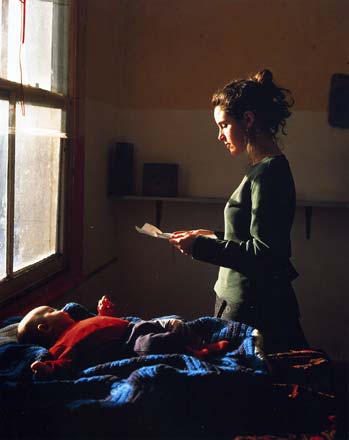
Woman Reading Possession Order, © Tom Hunter, 1997. From the series Persons Unknown.
Hunter is interesting as his work has often concentrated on a very small geographical area, that of his home in East London and particularly Hackney, while his subjects have tended to be members of the community of travellers he knows as neighbours and friends. (It’s worth noting the work of Stephen Gill whose photographs have also extensively explored the area of Hackney). I’ve not got time to discuss Hunter’s work, instead here are a selection of photographs from various series he’s made in Hackney over the past few years, along with links to some articles and audio interviews.
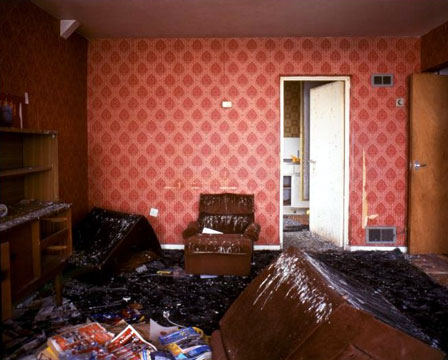
© Tom Hunter

© Tom Hunter
These two images are from the series Empty Towerblock, which Hunter describes as: “The empty tower block stands as a symbol of a paradigm failure in UK social policy: the Dystopia and ultimate waste of castle-in-the-air housing projects which were scrapped and abandoned. They are all the more poignant a choice for imaging, given that tower blocks were originally meant to be a dream (Utopian) solution to the issue of ‘decent’ housing.”
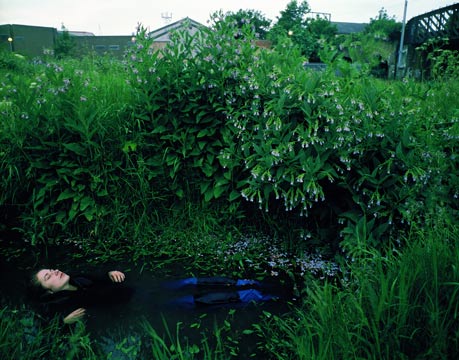
The Way Home © Tom Hunter, 2000
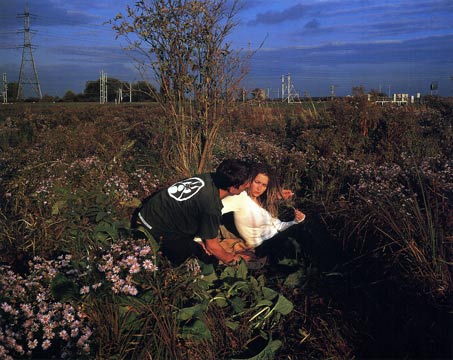
The Hackney Man © Tom Hunter, 2000
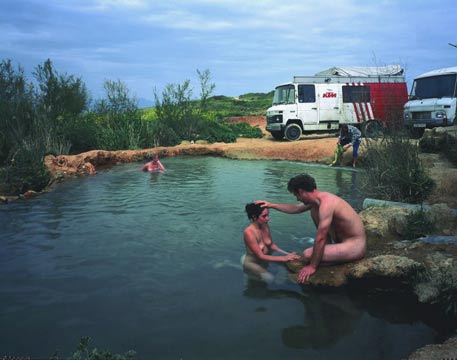
After The Dragon © Tom Hunter, 2000
These last three images are taken from his series, Life and Death in Hackney, which he describes as: “More overtly than other series, these images convey a bleak outlook, but one which is familiar and fair, and broadly resonant with today’s society. Subjects are shown in soporific states, or role-playing ‘death scenes’, and these are located in overgrown fields, wasteland, or graveyards….This assists the ethereal, or ‘other-worldly’, quality to the frames as the wild, untouched-looking country found in Hackney seems apocryphal and ‘dream-like’, despite its contemporary reality.”
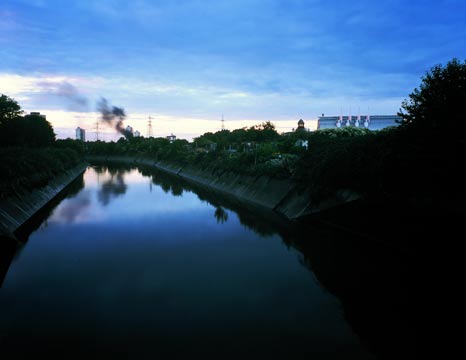
Crows Road © Tom Hunter, 2002. From his Swan Song series.
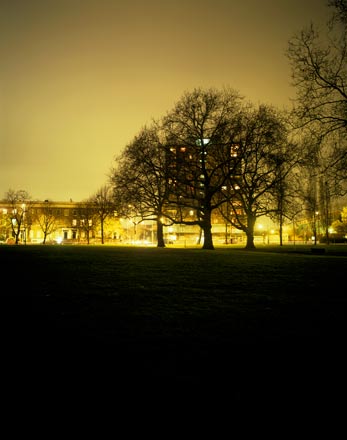
London Fields © Tom Hunter, 2003. From his Swan Song series.
Hunter’s show at the National Gallery, Living in Hell and Other Stories, took as its subject the lives of the ordinary residents of Hackney, as reported in local newspapers. These often startling stories are told in carefully staged photographs derived from Renaissance paintings. You can read an article about the work by Martin Herbert here.
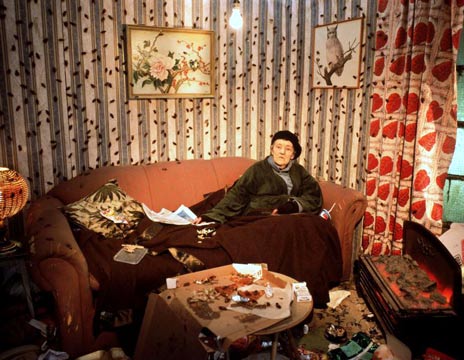
Living in Hell, © Tom Hunter, 2004
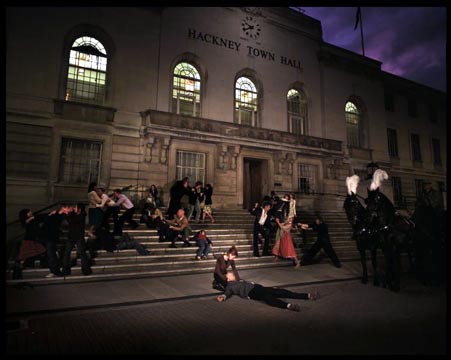
For Batter Or Worse © Tom Hunter, 2004
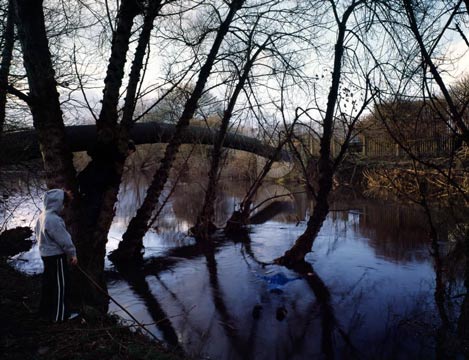
Gangland Execution Boys Find Man’s Body In River © Tom Hunter, 2004

Murder Two Men Wanted © Tom Hunter, 2004

Rat in Bed © Tom Hunter, 2004
You can watch a slideshow and audio tour of the National Gallery show on the Guardian’s website here. While James Lomax discusses the exhibition on his blog here.
Here is an interview with Hunter on ePhotozine.
Posted in OTHER STUDIES | Comments Off on TOM HUNTER’S HACKNEY
There’s an interview with Magnum photographer Chris Steele-Perkins in the current issue of the RPS Journal (March 2009) where Steele-Perkins discusses a retrospective of his work shot in England, which he is currently editing.
Apparently the project will collect material shot during the course of Steele-Perkins’ career, from his student work, to what he is shooting now. “I’ve not been interested in doing retrospective books”, he says, “but I realised I’ve been photographing England for about 40 years. If I’ve got three picture from every year, that’s 120 pictures.”
Looking through this huge body of work, he says, themes emerge of which he was only vaguely aware hitherto. “I’ll probably run it chronologically”, he tells David Land, “because it’s interesting to see a theme re-appearing over time in slightly different ways.”
“This is the first time I’ve looked back. I’m trawling through my old contact sheets, and finding images that haven’t been printed up, that were lost, or put into the Magnum system and forgotten about. It’s interesting, because you forget about the stories you’ve done, but it’s also tedious: you do shoot a lot of muck, and are reminded of all those mediocre pictures you’ve shot.”
The book will published by Northumbria University Press. Hopefully it will include some of these (not mediocre) photographs taken from his previous publications, The Teds (1979, re-published by Dewi Lewis, 2003) and The Pleasure Principle (Cornerhouse, 1995).
Pub in Bradford © Chris Steele-Perkins, 1976
Brothers, Red Deer, Croydon © Chris Steele-Perkins, 1976
Prime Minister Margaret Thatcher, Conservative Party Conference Ball © Chris Steele-Perkins, 1985
Hypnotism session at Student Ball © Chris Steele-Perkins, 1989
You can see more of Steele-Perkins’ work on his website.
Posted in OTHER STUDIES | 1 Comment »
February 20th, 2009 admin
I was at Michael Hoppen Gallery yesterday and had the chance to see the work of Japanese photographer Hiromi Tsuchida. I was particular excited to see a series of exhibition prints from his book Counting Grains of Sand (Published: Tosei-Sha, May 2005).
Born in Fukui Prefecture in 1939 Tsuchida studied engineering before enrolling in the Tokyo College of Photography in 1965 where he was later to return as a professor. He began his career as a publicity photographer for a cosmetics company but quickly decided to become a freelance photographer in 1971. Tsuchida began Counting Grains of Sand in the second half of the 1970s and the series explores how the Japanese people interact and function in a crowd, with each person a ‘grain of sand’. He decided to stop working on the series in 1989, when the ‘crowd to end all crowds’ came to mourn the death of Emperor Hirohito. However, during the 1990s he began work on the series again as he was struck by the shifting dynamic of the crowd in the today’s Japan. Crowds were no longer seas of people but had become a network of small groups that maintained a certain distance from each other.
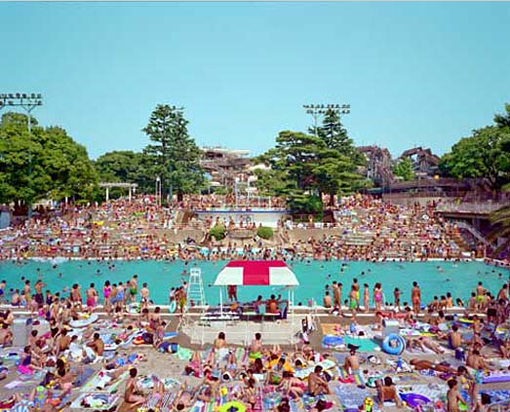
Untitled, Tokyo © Hiromi Tsuchida, 1996
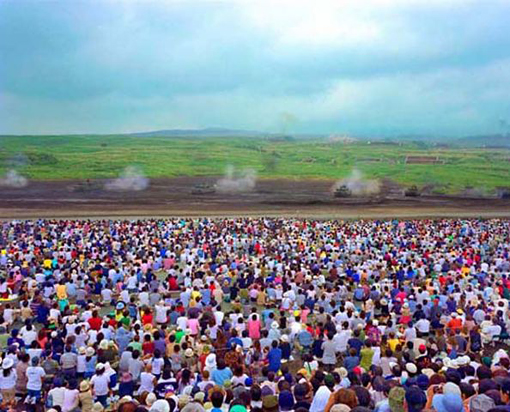
Untitled, Gotemba © Hiromi Tsuchida, 2002
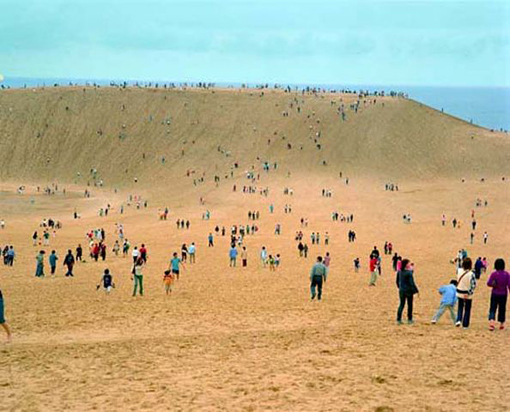
Untitled, Tottori © Hiromi Tsuchida, 2002
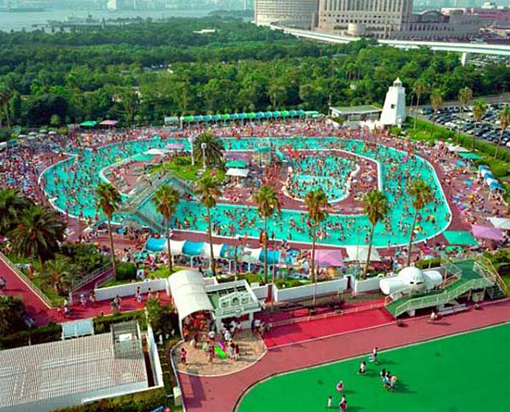
Untitled, Tokyo © Hiromi Tsuchida, 2003
Tsuchida attempts to express the changes in Japanese culture and society through his work, analyzing the distance within crowds and the clash between tradition and modernity that structures Japanese society. His photographs have been described as “the intersection between the individual and the communal, within the global context of urbanization and consumerism.” And it has been said that his work highlights the “unification brought about by the sacred and the profane within the context of a society with this dual structure. Doing so he captures a universal element that exists outside of time and indifferent to western influences.”
His vivid use of colour give the images an almost hyper-real quality and help convey a sense of claustrophobia while at the same time the crowds seem very ordered.
You can see a few more of Tsuchida’s work on Artnet here.
Posted in OTHER STUDIES | Comments Off on COUNTING GRAINS OF SAND
February 12th, 2009 admin
“Fay Godwin is one of our best known landscape photographers, a master of scenery in black and white, and incidentally, working out in photography a long-tradition of subtly depicting the politics of the British countryside.†Chris Townsend, Hot Shoe , July 1999
Following on from my recent posts about photographers looking at the politicised nature of the English countryside (Dark Days and Tomorrow We Enter Paradise) I want to turn to the work of noted British photographer Fay Godwin (17 February 1931 – 27 May 2005). A photographer who, having established herself in portraiture, became known for her black and white landscape photographs which often had a political strand. Indeed in later years her photographs became a more overt criticism of the environmental damage and access restrictions imposed on the land, across England.
Influenced by Bill Brandt and Paul Strand, she looks for the narrative in her landscapes, choosing to record man’s relationship with the environment.
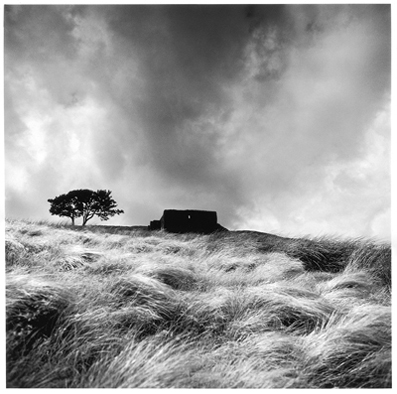
Top Withens, Calder Valley © Fay Godwin, 1977
“I had no aspirations to become a landscape photographer at all. In fact it was portraiture that was my beginning, I suppose. I have always been a very keen walker, though, and I often took a camera with me on my walks. But I was, and still am, an avid reader and so when I first started I chose to photograph many of the great writers in this country to try and earn a living.” Fay Godwin, 2004
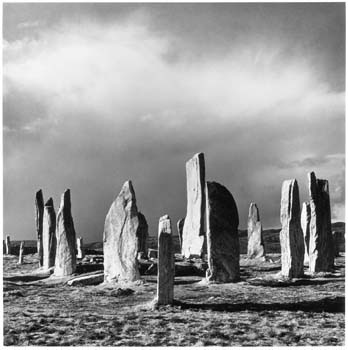
Callanish after hailstorm, Lewis © Fay Godwin, 1980
Godwin was self-taught, her interest developed during the 1960s through taking pictures of her young family. Having established herself in literary portraiture, she moved onto publishing her landscape work in a series of walkers’ books (see full list here). In 1978, she received an award from the UK arts council, and her best known exhibition ‘Land’ was shown at the Serpentine Gallery in London, 1985, and is regarded by many as the finest study of British landscape ever published setting new standards in British landscape photography.
While I appreciate Godwin’s landscape photographs, the images I’m really drawn to are those which present a dry humour and, much like Tony Ray-Jones, a keen eye for the quietly absurd. Here are some of my favourite photographs, which can be found in the ‘snaps’ section of her website:
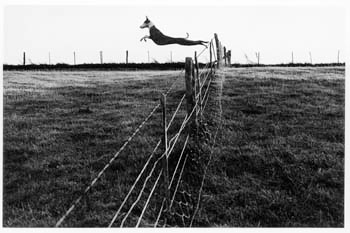
Leaping lurcher © Fay Godwin, 1972
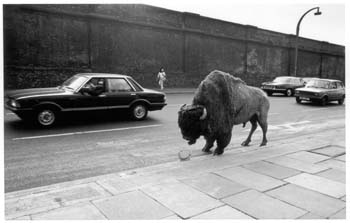
Bison at Chalk Farm © Fay Godwin, 1981
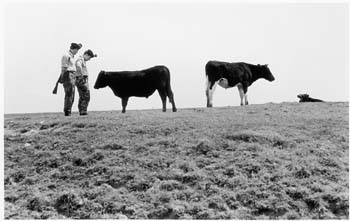
Soldiers and bullocks, Romney Marsh © Fay Godwin, 1973
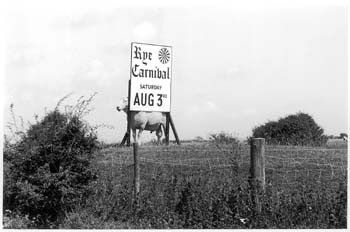
Rye Carnival © Fay Godwin, 1985
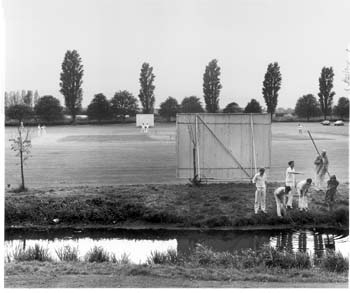
Cricket at Sandwich © Fay Godwin, 1981
From 1979 Godwin started experimenting in colour, which eventually led to a deliberate attempt to move out of the black and white landscape genre. This was helped through a Fellowship at the National Museum of Photography, Film and Television, (Bradford 1987/8) culminating in an exhibition ‘Bradford in Colour’. During the early 1990s, Godwin’s eventual move to colour close-ups was widely misinterpreted as a necessity due to failing health, rather than creative progression. Godwin’s own view was: “Because in a dreary British way, I had been pigeon-holed as a black and white photographer and at my age it was not permissible to move on.”
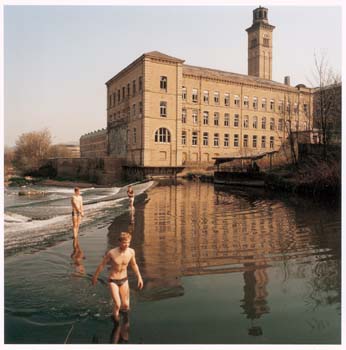
Boys in River, Salts Mill © Fay Godwin, 1987
“I’ve always been interested in our relationship with the land. There is so much of great beauty and historical interest, but when I look at the British Isles I am also angered and saddened by the relentless butchering of our heritage by money-grabbing corporations.” Fay Godwin, 2004
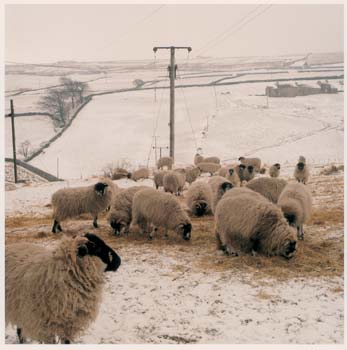
Ponden Moor © Fay Godwin, 1987
In 2001 Godwin was honoured with a major retrospective, ‘Landmarks’ at the Barbican Centre, in London. Landmarks went on to tour internationally. An associated book was published by Dewi Lewis.
“I don’t get wrapped up in technique and the like. I have a simple rule and that is to spend as much time in the location as possible. You can’t expect to take a definitive image in half an hour. It takes days, often years. And in fact I don’t believe there is such a thing as a definitive picture of something. The land is a living, breathing thing and light changes its character every second of every day. That’s why I love it so much.†Fay Godwin, 2004
Interestingly I came across this photograph by Godwin:
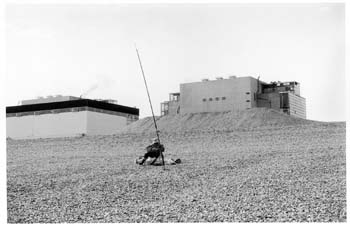
Sleeping Fisherman, Dungeness © Fay Godwin, 1974
Which reminds me of a similar photograph I took last summer for We English:
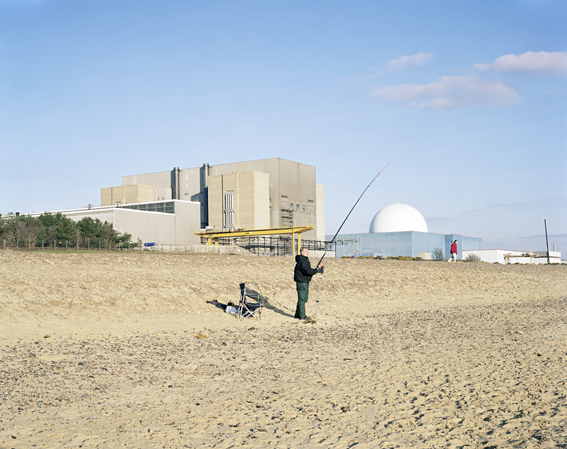
Fisherman, Sizewell Power Station © Simon Roberts, 2008
You can read a longer biography of Godwin here and the last interview she gave with David Corfield for Practical Photography in December 2004 here (where her quotes are taken from above).
Posted in OTHER STUDIES | Comments Off on FAY GODWIN














